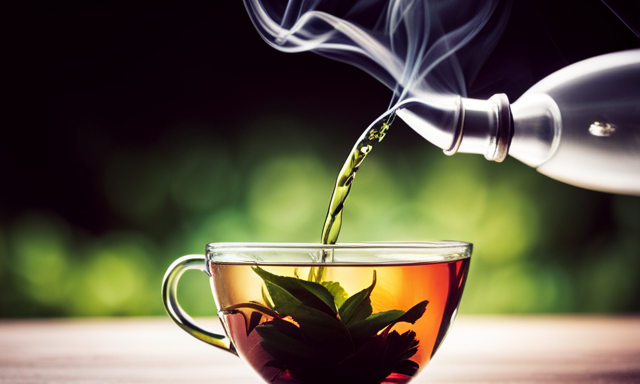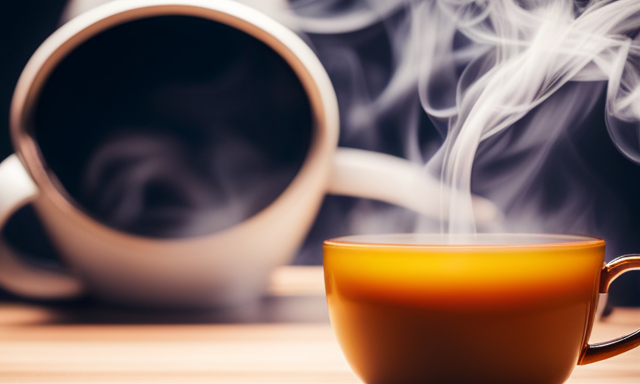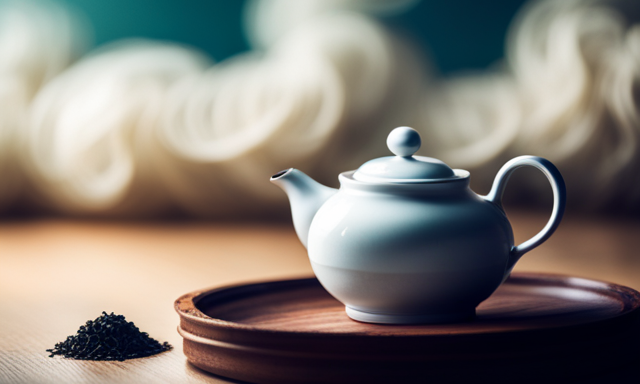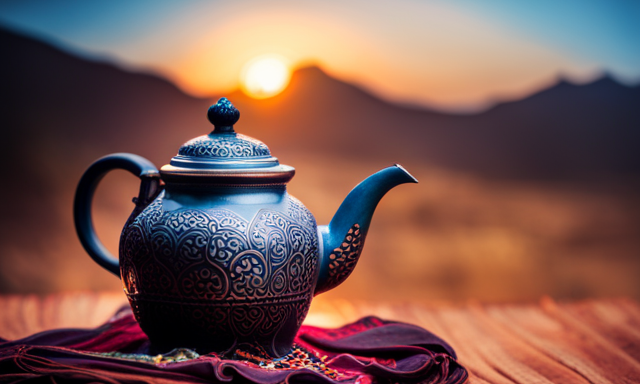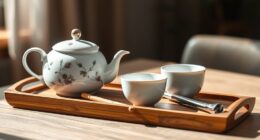Did you know that loose leaf tea has been enjoyed for centuries and is known for its rich flavors and health benefits?
In this article, I will guide you through the art of brewing loose leaf jasmine and oolong tea, two popular and aromatic varieties. Whether you’re a tea enthusiast or a beginner looking to explore the world of tea, this step-by-step guide will help you brew the perfect cup every time.
We will start by understanding the basics of loose leaf tea and how to prepare your tea set for brewing.
Then, I will share detailed instructions on brewing jasmine tea, known for its delicate floral aroma, and oolong tea, prized for its complex flavors.
You will also learn about different steeping techniques and how to appreciate the unique characteristics of each tea.
Additionally, I will provide tips on pairing tea with food, storing and preserving tea, and even experimenting with different tea variations.
So, grab your teapot and let’s embark on a journey to discover the art of brewing loose leaf jasmine and oolong tea.
Key Takeaways
- Tea infusers are essential for controlling the steeping process of loose leaf jasmine and oolong tea.
- Experimenting with herbs and spices can add unique flavors to the tea.
- Proper storage techniques, such as using opaque containers and protecting the leaves from light and strong odors, are important for maintaining the freshness and flavor of the tea.
- Brewing techniques and equipment, such as temperature-controlled kettles and tea timers, can enhance the brewing experience and ensure a precise brew.
Understanding Loose Leaf Tea
Now that you’ve got your hands on some loose leaf tea, it’s time to dive into the rich and intricate world of brewing. Understanding tea grades is essential in order to fully appreciate the quality and flavor of your loose leaf tea. Tea grades are based on factors such as the size, shape, and quality of the leaves. Higher grades usually consist of whole, unbroken leaves, while lower grades may include broken leaves and stems. Opting for loose leaf tea over tea bags also offers numerous benefits.
Loose leaf tea tends to have a fresher and more vibrant taste compared to tea bags, which often contain lower quality tea dust or fannings. Additionally, loose leaf tea allows for more control over brewing time and strength.
Now, let’s move on to preparing your tea set.
Preparing Your Tea Set
First, gather all the necessary items for your tea set, like a teapot, teacups, and a tea tray. When choosing a teapot, consider the size and material. A clay teapot is ideal for oolong tea as it enhances its flavors, while a glass teapot is perfect for jasmine tea as it allows you to appreciate the beautiful blooming process. Ensure your teapot has a tight-fitting lid and a built-in strainer to prevent tea leaves from escaping.
Temperature control is crucial for brewing tea. Use a thermometer or an electric kettle with temperature settings to heat water to the appropriate temperature for each type of tea.
Now that you have your tea set ready, let’s move on to brewing jasmine tea.
Transition: Now that your tea set is prepared, let’s dive into the art of brewing jasmine tea.
Brewing Jasmine Tea
To start your journey into the world of brewing jasmine tea, you’ll need to master the art of steeping delicate, fragrant flowers in hot water. Jasmine tea is not only delicious but also has numerous health benefits. It’s known to boost the immune system, reduce stress, and improve digestion.
There are various jasmine tea recipes you can try, such as jasmine green tea or jasmine pearl tea. To brew jasmine tea, start by boiling water and letting it cool slightly. Place a teaspoon of jasmine tea leaves in a teapot or infuser. Pour the hot water over the leaves and let it steep for 3-5 minutes. The aroma of jasmine will fill the air as the tea infuses.
Now, let’s move on to the next section about brewing oolong tea.
Brewing Oolong Tea
Indulging in the rich and complex flavors of oolong is like embarking on a sensory journey that captivates the taste buds and transports you to a world of aromatic bliss. Understanding oolong tea is essential to brewing a perfect cup. Here are some key points to consider:
- Oolong tea is a partially oxidized tea, falling between green and black tea.
- Its flavor profile varies from fruity and floral to toasty and nutty, depending on the level of oxidation.
- Oolong tea offers numerous benefits, such as boosting metabolism, aiding digestion, and promoting heart health.
- To brew oolong tea, use water heated to around 190-200°F and steep the leaves for 2-3 minutes.
- Experiment with multiple infusions to fully appreciate the tea’s evolving flavors.
Moving on to the subsequent section about steeping techniques, it’s important to explore various methods to enhance the oolong tea experience.
Steeping Techniques
Discover the perfect steeping techniques for unlocking the full flavor potential of your favorite oolong, and did you know that using a gaiwan can increase the number of infusions you can enjoy? To make the most of your oolong tea, it is important to pay attention to the tea temperature and steeping time. Different oolong teas require different temperatures and steeping times to bring out their unique flavors. For lighter oolong teas, such as green oolong, the water temperature should be around 180°F (82°C) and the steeping time should be 2-3 minutes. For darker oolong teas, like roasted oolong, the water temperature should be around 200°F (93°C) and the steeping time should be 3-5 minutes. Adjusting the temperature and steeping time can help you achieve the desired strength and taste. By mastering these techniques, you will be able to fully appreciate the complex flavors of oolong tea. Now, let’s move on to tasting and appreciating the tea.
Tasting and Appreciating the Tea
Savoring and appreciating the delicate nuances of this exquisite beverage is an art form that requires patience and a discerning palate. When tasting loose leaf jasmine and oolong tea, there are key elements to observe in order to fully appreciate its complexity. Here are three important steps to enhance your tea-tasting experience:
-
Appreciating Aroma: Before taking a sip, inhale the fragrant steam rising from the cup. Note the floral and earthy notes that dance in the air. The aroma gives a preview of the flavors to come.
-
Analyzing Flavors: Take a small sip and let the tea coat your taste buds. Pay attention to the subtle flavors that unfold, such as the floral sweetness of jasmine or the smooth, nutty undertones of oolong. Notice how the flavors evolve with each sip.
-
Noting Aftertaste: After swallowing, pay attention to the lingering aftertaste. Does it leave a refreshing sensation, a lingering sweetness, or a subtle bitterness? The aftertaste reveals the tea’s quality and complexity.
As you appreciate the tea’s aroma and analyze its flavors, you’ll be better equipped to pair it harmoniously with food.
[Transition into the subsequent section about pairing tea with food].Pairing Tea with Food
When it comes to pairing tea with food, I always strive to find complementary flavors that enhance the overall experience. By carefully selecting the right combination, the flavors of both the tea and the food can be elevated to new heights.
Additionally, exploring traditional tea and food pairings can offer a glimpse into different cultures and their culinary traditions, adding a layer of depth and appreciation to the experience.
Finding complementary flavors
To enhance your tea-drinking experience, imagine the tantalizing dance of flavors as you explore the perfect pairings for your jasmine and oolong teas.
When it comes to floral tea combinations, jasmine tea pairs exceptionally well with light and fruity desserts. The delicate floral notes of jasmine tea complement the sweetness of desserts like mango sorbet or lemon tart, creating a harmonious balance of flavors.
On the other hand, oolong tea’s complex and robust taste can be enhanced by pairing it with rich and creamy desserts. Think of indulgent treats like chocolate cake or crème brûlée that bring out the earthy and nutty undertones of oolong tea.
These complementary flavors create a truly delightful tea and dessert experience. Now, let’s explore how we can further enhance the tea and food pairing experience.
Enhancing the tea and food pairing experience
Indulge in the exquisite symphony of flavors by discovering the perfect combination of delectable dishes that elevate your tea-drinking experience. To enhance the tea and food pairing experience, it is important to consider the use of complementary tea accessories and creating unique tea flavors. Pairing your jasmine and oolong tea with the right accessories can enhance the aroma and taste, such as using a glass teapot to showcase the beautiful tea leaves and a tea infuser to control the steeping process. Additionally, you can experiment with creating unique tea flavors by adding ingredients like fresh fruits, herbs, or spices to your tea. This allows you to personalize the taste and create a truly delightful experience.
To further explore traditional tea and food pairings, we can delve into the rich history and cultural significance of these combinations.
Exploring traditional tea and food pairings
Discover the captivating cultural tapestry woven into traditional tea and food pairings as we explore the rich history behind these harmonious combinations.
Traditional tea ceremonies have long been a cherished practice in many cultures. From the elegant Japanese tea ceremony to the elaborate Chinese Gongfu tea ceremony, these ceremonies not only showcase the art of brewing tea but also highlight the importance of pairing tea with specific foods.
The careful selection of food enhances the flavors of the tea, creating a truly immersive sensory experience. Moreover, tea itself offers a myriad of health benefits, from boosting immunity to aiding digestion.
By understanding the traditional tea and food pairings, we can not only appreciate the cultural significance behind it but also enjoy the numerous health benefits that these combinations offer.
Now, let’s delve into the art of storing and preserving tea, ensuring its freshness and flavor for the ultimate tea experience.
Storing and Preserving Tea
Savor the taste of stored and preserved tea with a touch of tranquility. Proper tea storage and preservation are essential to maintaining the freshness and flavor of loose leaf jasmine and oolong tea.
To keep your tea at its best, store it in an airtight container away from light, heat, and moisture. Avoid exposure to strong odors that can contaminate the tea’s aroma. Additionally, consider using opaque containers to further protect the leaves from light damage.
When it comes to preservation, it’s crucial to keep the tea away from any strong-smelling substances that can alter its delicate taste. By following these simple guidelines, you can ensure that your tea remains aromatic and full of flavor for an extended period.
Now, let’s explore the exciting world of experimenting with tea variations.
Experimenting with Tea Variations
When it comes to experimenting with tea, there are endless possibilities to enhance your tea-drinking experience. One way is by adding herbs and spices to your tea, which can bring out unique flavors and aromas.
Another option is creating your own tea blends, allowing you to customize your tea to your personal taste preferences.
Additionally, exploring different brewing techniques and equipment can open up a whole new world of tea flavors and textures. So, don’t be afraid to get creative and try new things with your tea!
Adding herbs and spices to your tea
Enhance your tea experience by incorporating herbs and spices into your loose leaf jasmine and oolong tea. Adding herbs and spices not only adds flavor and aroma but also brings additional health benefits. Here are a few ideas to get you started:
-
Herbal infusions for relaxation and sleep: Chamomile, lavender, and lemon balm are excellent choices for a calming and soothing tea that promotes relaxation and aids in sleep.
-
Spices to add warmth and depth to your tea: Cinnamon, ginger, cardamom, and cloves are perfect for adding a touch of warmth and depth to your tea, making it perfect for chilly evenings.
-
Experiment with different combinations: Mix and match your favorite herbs and spices to create unique flavors that suit your palate. Don’t be afraid to get creative and try new combinations.
-
Adjust the quantity to your taste: Start with a small amount of herbs and spices, and gradually increase or decrease according to your preference.
By incorporating herbs and spices into your tea, you can create a personalized blend that suits your taste and preferences. In the next section, we’ll explore the art of creating your own tea blends.
Creating your own tea blends
Try experimenting with different combinations of herbs and spices to create your own unique blend of tea that perfectly suits your taste and preferences. Creating your own tea blends allows you to personalize your tea experience and discover new flavors. Not only does it add a touch of creativity to your tea routine, but it also provides various benefits. Homemade tea blends are free from artificial flavors and preservatives, ensuring a healthier and more natural beverage. Additionally, you can tailor the blend to address specific health concerns or to promote relaxation. To get started, consider the following table as a guide for combining different herbs and spices:
| Base Tea | Flavoring | Health Boost |
|---|---|---|
| Green tea | Ginger | Immune support |
| Rooibos | Peppermint | Digestive aid |
| Chamomile | Vanilla | Relaxation |
| Black tea | Cinnamon | Antioxidant boost |
| Oolong tea | Lemon verbena | Metabolism booster |
By creating unique blends, you can enjoy a wide range of flavors and harness the benefits of homemade tea. Now, let’s explore different brewing techniques and equipment to further enhance your tea experience.
Exploring different brewing techniques and equipment
Let’s dive into the world of brewing techniques and equipment to elevate your tea experience even more! Here are four essential items that will enhance your tea brewing process:
-
Temperature-Controlled Kettle: Maintaining the right brewing temperature is crucial for extracting the flavors and aromas from your tea leaves. Invest in a kettle with adjustable temperature settings to ensure your tea is brewed to perfection.
-
Infusers and Strainers: These accessories allow you to steep loose leaf tea without the hassle of leaves floating in your cup. Choose from a variety of infusers and strainers, such as tea balls or mesh strainers, to suit your brewing preferences.
-
Tea Timer: Timing is everything when it comes to brewing tea. A tea timer will help you achieve the ideal steeping time for different types of tea, ensuring a balanced and flavorful brew every time.
-
Tea Warmer: Keep your brewed tea warm for extended enjoyment with a tea warmer. These compact devices use a candle or electric heat source to maintain the temperature of your tea, so you can savor each sip at your own pace.
By incorporating these brewing techniques and tea brewing accessories into your routine, you’ll be able to brew loose leaf jasmine and oolong tea with precision and finesse.
Frequently Asked Questions
Can I use the same tea leaves to brew both jasmine and oolong tea?
Absolutely not! Mixing different types of tea leaves together can result in a disastrous flavor explosion! However, you can brew jasmine and oolong tea separately, then combine them for a unique and delightful flavor profile.
How long should I steep jasmine and oolong tea for optimal flavor?
To achieve a strong flavor in jasmine and oolong tea, steep the leaves for 3-5 minutes. For long term freshness, store loose leaf tea in an airtight container away from light, heat, and moisture.
Can I add sweeteners or milk to jasmine and oolong tea?
Adding sweeteners or milk to jasmine and oolong tea can alter the delicate flavor profiles. While some may enjoy the added sweetness or creaminess, it can overpower the natural floral or fruity notes, so it’s best to savor these teas on their own.
What is the difference between loose leaf jasmine tea and jasmine tea bags?
Loose leaf jasmine tea offers higher quality and a more authentic flavor compared to tea bags. While tea bags provide convenience, they often contain lower-grade tea leaves and less fragrance.
Can I reuse the tea leaves for multiple infusions?
One sip and I’m hooked – reusing tea leaves for multiple infusions is a tea lover’s secret weapon. It unlocks a world of flavors, like a hidden treasure waiting to be discovered with each steep.
Conclusion
In conclusion, brewing loose leaf jasmine and oolong tea is like embarking on a delightful journey of flavor and aroma. By understanding the nuances of these teas and following the proper brewing techniques, you can create a truly satisfying tea experience.
From the moment you prepare your tea set to the final sip, every step is an opportunity to savor the artistry of tea-making. So go ahead, explore the world of tea and let your taste buds dance with joy. Happy brewing!

